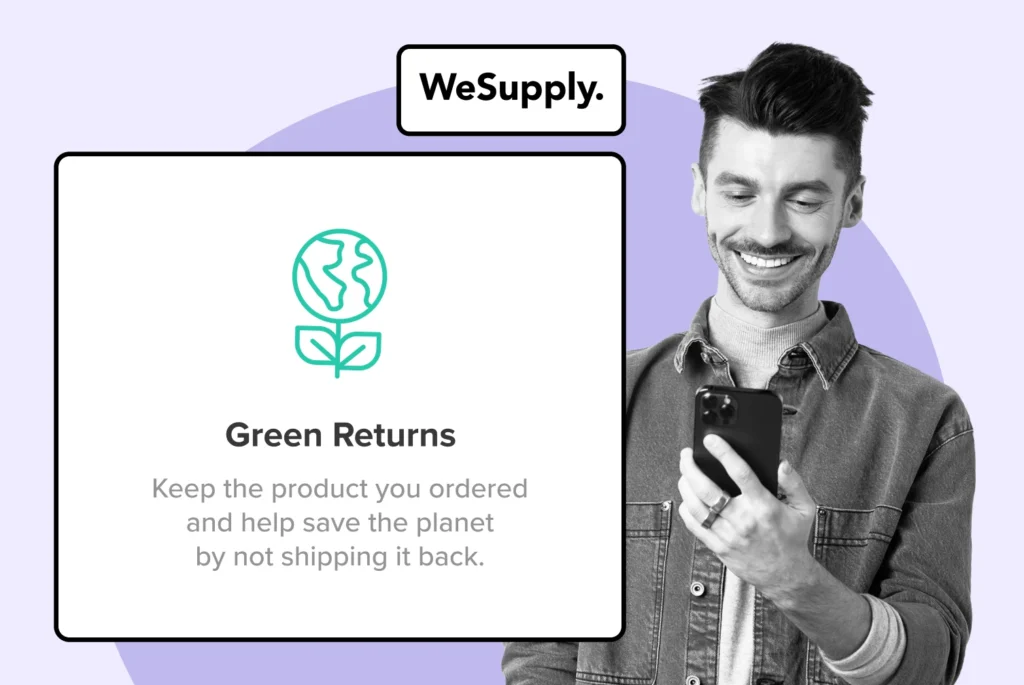
Understanding the Anchoring Effect on Customer Returns: Strategies and Impacts
Let’s explore how the anchor – often the initial price – can impact return rates, satisfaction, and ultimately, a business’s bottom line!
Shipping, Tracking & Notifications
Boost customer experience and reduce support tickets
Realtime order and shipment tracking
Proactive order and shipping notifications
AI-Enhanced Discounted Labels
Predictive pre-purchase estimated delivery dates
Self-Serivce branded order tracking
Effortless experience delivered
Identify and Resolve Order Issues
Realtime order and shipment tracking
Make returns profitable and delight customers
Flexibility to define any return destinations & conditions
Simplify returns for your customers and team
Incentivize exchanges over returns
Returns management made easy for your team
Returns management made easy for your team
Easy claims and smart upsells
Understand why your customers are returning
In-Store & Curbside Pickup
Unify the online and the in-store experience
Hassle-free pickup experience for customers
In-Store dashboard to keep operations streamlined
In-Store and Online orders unified
Drive foot-traffic to your stores
Shipping, Tracking & Notifications
Boost customer experience and reduce support tickets
Realtime order and shipment tracking
Proactive order and shipping notifications
AI-Enhanced Discounted Labels
Predictive pre-purchase estimated delivery dates
Self-Serivce branded order tracking
Effortless experience delivered
Identify and Resolve Order Issues
Realtime order and shipment tracking
Make returns profitable and delight customers
Flexibility to define any return destinations & conditions
Simplify returns for your customers and team
Incentivize exchanges over returns
Returns management made easy for your team
Returns management made easy for your team
Understand why your customers are returning
In-Store & Curbside Pickup
Unify the online and the in-store experience
Hassle-free pickup experience for customers
In-Store Dashboard to keep operations streamlined
In-Store and Online orders unified
Drive foot-traffic to your stores
Boost customer experience and reduce support tickets
Realtime order and shipment tracking
Proactive order and shipping notifications
AI-Enhanced Discounted Labels
Predictive pre-purchase estimated delivery dates
Self-Serivce branded order tracking
Effortless experience delivered
Make returns profitable and delight customers
Flexibility to define any return destinations & conditions
Simplify returns for your customers and team
Incentivize exchanges over returns
Returns management made easy for your team
Equip your team for precise return checks.
Easy claims and smart upsells
Understand why your customers are returning
Unify the online and the in-store experience
Hassle-free pickup experience for customers
In-Store Dashboard to keep operations streamlined
In-Store and Online orders unified
Drive foot-traffic to your stores
Find the answer to all your questions
Take a step by step trip through our functionality to see how we can improve your ecommerce processes.
Explore the most comon questions about WeSupply
Calculate the ROI that WeSupply can bring you
Read actionable articles on how to optimize your post-purchase experience and decrease support tickets
Get inspired by stories of how our customers implemented an effortless post-purchase experience
Wondering if WeSupply is a good fit for you? Read through our use cases to see how we can help you increase conversion & improve CX!
A Deep Dive into Top Companies' Order Tracking & Returns Strategy
Find the answer to all your questions
Explore the most comon questions about WeSupply
Calculate the ROI that WeSupply can bring you
Request a no strings attached review of your current shopping experience and missed conversion opportunities
Take a step by step trip through our functionality to see how we can improve your ecommerce processes.
Read actionable articles on how to optimize your post-purchase experience and decrease support tickets
Get inspired by stories of how our customers implemented an effortless post-purchase experience
A Deep Dive into Top Companies' Order Tracking & Returns Strategy
Wondering if WeSupply is a good fit for you? Read through our use cases to see how we can help you increase conversion & improve CX!

If you’re searching for practical ways to enhance your eCommerce business’s environmental impact, keeping track of sustainability metrics is non-negotiable. This article zeroes in on vital sustainability metrics to track in eCommerce — from assessing carbon output to reducing packaging waste — that are essential for sustainable operations and customer trust. We’ll guide you through measuring, interpreting, and leveraging these metrics for a green business model that stands the test of time, without spoiling the in-depth analysis and tips that follow.
Consumer demand for sustainable products is reshaping the eCommerce landscape, mandating ethical practices across industries such as fashion, food, cosmetics, and pharmaceuticals.
Sustainability metrics involving energy consumption, water usage, waste management, and carbon emissions are critical for eCommerce businesses to quantify environmental impact and drive efficient operations.
Implementing sustainable practices across the supply chain, from ethical sourcing to optimized transportation, is essential for minimizing environmental impact and building consumer trust and brand loyalty.
WeSupply revolutionizes eCommerce sustainability by integrating technology for streamlined returns. Our branded portal, self-service process, and autogenerated QR code labels enhance customer loyalty and simplify returns. Green Returns reduce waste, while restocking options and intelligent dispositions ensure efficient management. With returns analytics, businesses optimize processes sustainably. Get started with WeSupply to transform your eCommerce operation sustainably.
In the fast-paced digital era, sustainability has become a non-negotiable aspect for eCommerce businesses. Consumers are becoming increasingly conscious of the environmental impact of their purchasing decisions, driving a surge in demand for sustainable goods. This shift is not confined to developed nations alone; it is a global phenomenon that is reshaping the eCommerce landscape. Indeed, as many as 75% of millennials are reported to factor sustainability into their purchasing decisions.
The eCommerce industry mandates that business practices coincide with environmental consciousness for long-term success. Not only does it reduce a company’s carbon footprint, but it also attracts a larger customer base, with online searches for sustainable goods having risen by a staggering 71% between 2016 and 2021. This strategic alignment with sustainability initiatives can also enhance the sustainability performance of eCommerce businesses, paving the way to a greener future.
The escalating consumer demand for sustainability is more than a trend; it’s a significant shift that’s transforming the eCommerce landscape. This shift is being driven by consumers aligning themselves with brands that prioritize environmental stability, resulting in significant market growth for sustainably sourced goods. This growth is not limited to certain sectors; it is evident across a wide range of industries, including:
Fashion
Food
Cosmetics
Pharmaceuticals
However, fulfilling this demand brings its own challenges. An interesting paradox has emerged where consumers express positive attitudes towards sustainable products yet do not consistently purchase eco-friendly products. This highlights the need for businesses to bridge this gap between consumer attitudes and actual purchasing behavior, which can be achieved by employing strategies such as using social influence and shaping good consumer habits towards sustainable consumption.
For eCommerce businesses, integrating business practices with environmental consciousness is not just a strategic requirement, but a crucial stride towards a sustainable future. This alignment requires a comprehensive approach, encompassing everything from product sourcing and manufacturing to packaging and delivery. For instance, by switching to green hosting platforms like Shopify, which is powered by 100% clean, renewable energy, eCommerce businesses can significantly reduce their carbon footprint related to web hosting.
Moreover, this alignment with environmental consciousness can also yield substantial economic benefits. For example, the recyclable nature of plastics, if harnessed correctly, could potentially create thousands of new jobs and add billions of dollars to the economy. Thus, aligning business practices with environmental consciousness is not just a strategic imperative, but a win-win scenario for both businesses and the environment.
WeSupply’s Returns Management Software stands at the forefront of strategic imperatives, aligning business practices with environmental consciousness. By seamlessly integrating sustainable practices into return processes, WeSupply not only streamlines operations but also minimizes environmental impact. Through efficient handling of returns, including recycling, WeSupply empowers businesses to reduce waste and carbon footprint, thus fostering a greener, more responsible approach to commerce.
For a sustainable future, eCommerce businesses must monitor and quantify their environmental impact, making sustainability metrics an integral part of their success. These metrics provide a quantifiable snapshot of a company’s sustainability efforts and performance, integrating life cycle analyses for an in-depth evaluation of products. Some key sustainability metrics that eCommerce businesses should monitor include:
Energy consumption
Water usage
Waste management
Carbon emissions
Packaging materials
Supply chain transparency
By tracking and improving these metrics, businesses can reduce their environmental footprint and contribute to a more sustainable future.
Moreover, these metrics are not just numbers on a page; they have the power to drive change. By focusing on sustainable business operations through sustainability metrics, businesses can:
Identify areas for resource conservation
Streamline processes
Improve operational efficiency
Achieve cost savings
Furthermore, transparent reporting of sustainability metrics can foster engagement among stakeholders and encourage collaborative efforts towards a greener future.
Monitoring sustainability metrics is more than just a checklist item; it serves as a vital step in evaluating the environmental repercussions of eCommerce operations. These metrics allow businesses to:
Set clear benchmarks for accountability
Measure their progress towards fulfilling their environmental goals
Gain insights into the environmental footprint of eCommerce operations
Identify areas for improvement
Implement sustainable practices
From energy consumption to packaging waste, environmental metrics provide valuable insights into the environmental footprint of eCommerce operations, helping businesses to identify areas for improvement and implement sustainable practices.
Moreover, these metrics can also have a financial impact. By identifying areas of high energy consumption or waste generation, businesses can implement targeted improvements, leading to increased operational efficiency and cost savings. This not only benefits the environment but also the business’s bottom line, proving that sustainability and profitability can go hand in hand.
WeSupply offers a transformative solution that not only enhances sustainability efforts but also significantly boosts ROI. Through its innovative features, WeSupply enables businesses to pinpoint areas of inefficiency, optimize operations, and ultimately drive down costs. By integrating sustainability practices seamlessly, WeSupply ensures that environmental responsibility directly contributes to financial gains. Experience the synergy of sustainability and profitability today with WeSupply. Try our ROI Calculator – and see where green initiatives meet increased revenue effortlessly.
When it comes to eCommerce sustainability, it’s crucial to look at the whole picture. This means going beyond the carbon footprint and examining a range of key metrics, including:
Energy consumption
Waste management
Water conservation
Supply chain sustainability
Each of these metrics provides a unique perspective on the environmental impact of eCommerce operations, helping businesses to identify areas for improvement and implement sustainable practices.
For example, packaging waste is a significant contributor to the environmental impact of eCommerce, with the production, use, and disposal of packaging accounting for about 45% of the carbon footprint in the industry. Measuring this impact through lifecycle assessments can help businesses to implement more sustainable packaging solutions and reduce waste.
For example, packaging waste is a significant contributor to the environmental impact of eCommerce, with the production, use, and disposal of packaging accounting for about 45% of the carbon footprint in the industry. Measuring this impact through lifecycle assessments can help businesses to implement more sustainable packaging solutions and reduce waste.
Likewise, monitoring the return rate is important for sustainability as it affects customer satisfaction, revenue, and environmental impact. By understanding and tracking these key metrics, eCommerce businesses can work towards a more sustainable future.
Comprehending and diminishing the carbon footprint stands as a key aspect of eCommerce sustainability. The carbon footprint is a measure of the total greenhouse gas emissions caused directly or indirectly by a company’s activities. These emissions can result from a variety of sources, including the sourcing of raw materials, manufacturing processes, and transportation.
By calculating their carbon footprint, eCommerce businesses can identify emission hotspots, assess climate risks and opportunities, and demonstrate their environmental responsibility to stakeholders.
A carbon footprint is more than just a buzzword; it’s a tangible measure of a company’s impact on the environment. It quantifies the total greenhouse gas emissions caused directly or indirectly by a company’s activities, including energy consumption, production processes, and transportation. This comprehensive assessment allows businesses to gain a clear understanding of their environmental impact and identify areas for improvement.
Calculating a carbon footprint can be a complex process, requiring comprehensive data on business activities, including both direct operations and indirect emissions like employee commuting and energy consumption during product use. However, tools and standards such as the GHG Protocol and ISO 14064 provide a framework for businesses to calculate their carbon footprint, making the process more manageable.
These tools can help businesses to measure sustainability performance and set clear targets for reducing their environmental impact.
Reducing a company’s carbon footprint is not just about cutting emissions; it’s about implementing a comprehensive strategy that targets all areas of environmental impact. This strategy involves everything from changing suppliers and optimizing resource consumption to enhancing energy efficiency. For example, adopting electric vehicles and eco-friendly practices for last-mile delivery can significantly reduce the carbon footprint of an eCommerce business.
In addition to these strategies, businesses can also invest in carbon offset projects to compensate for emissions that cannot be immediately reduced. These projects, which can range from reforestation to renewable energy initiatives, help to balance out the emissions produced by the business, leading to a net zero carbon footprint. By implementing these strategies, eCommerce businesses can make a significant contribution to reducing global greenhouse gas emissions and achieving a more sustainable future.
WeSupply revolutionizes eCommerce operations by implementing cutting-edge strategies to reduce carbon footprint. With features tailored to sustainability, businesses can optimize their environmental impact while enhancing customer satisfaction. Key features include:
Printerless Returns via QR Code: Enhancing customer experience, WeSupply offers QR code-based returns, eliminating the need for printing shipping labels.
Intelligent Dispositions: WeSupply’s intelligent system directs returned items to appropriate channels, such as recycling centers, ensuring a positive environmental impact from product returns.
With WeSupply, businesses can seamlessly align eCommerce operations with eco-conscious strategies, enhancing sustainability while improving overall efficiency. Let’s turn your challenges into opportunities! Book a demo with WeSupply today and discover the future of eco-conscious commerce.
Reduce Operating Cost with Advanced Return Policies
There are many moving pieces in ecommerce logistics. Book a quick call with our experts to see how WeSupply can help you take control by creating custom policies to handle them all easily.
Energy consumption holds a significant role in determining the environmental impact of eCommerce operations. From powering data centers and warehouses to transporting products, energy usage is a significant contributor to the carbon footprint of the eCommerce industry. However, by understanding and tracking their energy consumption, eCommerce businesses can identify opportunities for optimization, reduce their environmental impact, and enhance their sustainability performance.
Evaluating energy usage in eCommerce operations is a critical step in optimizing for efficiency and sustainability. To do this, businesses can use tools such as carbon calculators, energy audits, or life cycle assessments to measure energy consumption and emissions across their operations. This thorough assessment helps to paint a clear picture of where energy is being used and where improvements can be made.
In addition to direct energy consumption, such as the energy used to power data centers and warehouses, businesses should also consider their indirect energy usage, such as the energy consumed during the transport of goods and the use of packaging materials. By taking a comprehensive approach to evaluating energy usage, businesses can set realistic goals for reducing energy use and transitioning to renewable energy sources, paving the way for a more sustainable future.
Implementing energy-saving strategies is an effective way for eCommerce businesses to minimize their environmental impact. These strategies may involve installing energy-efficient equipment, optimizing processes, and investing in renewable energy sources. For example, installation of solar panels on warehouse roofs can provide a renewable energy source that reduces dependence on fossil fuels.
Moreover, energy-saving strategies can also have financial benefits. By reducing energy consumption, businesses can cut operational costs and improve their bottom line. Therefore, implementing energy-saving strategies is not just good for the environment; it’s also good for business.
For eCommerce businesses aiming to lessen their environmental impact, waste management is a vital consideration. Specifically, packaging waste is a significant contributor to the waste generated in the eCommerce industry, with the production, use, and disposal of packaging materials accounting for a large portion of the carbon footprint.
However, by reducing packaging waste and promoting recycling, businesses can minimize their environmental impact and move towards a more sustainable model.
One of the key strategies for reducing packaging waste in eCommerce is to utilize eco-friendly packaging materials. These materials, which include paper, cardboard, and bioplastics, are often recyclable or biodegradable, helping to reduce the environmental impact of packaging waste. Furthermore, these materials can provide a positive customer experience, as many consumers appreciate the effort to reduce waste and use more sustainable packaging.
In addition to using eco-friendly materials, businesses can also reduce packaging waste by implementing minimalist design principles. Minimalist packaging not only uses fewer resources but also provides a sleek and modern aesthetic that can enhance the unboxing experience for customers. By tackling packaging waste head-on, eCommerce businesses can make a significant contribution to waste reduction and promote a more sustainable future.
Promoting recycling is another crucial component of waste management in eCommerce. By encouraging the reuse of packaging materials and implementing recycling programs, businesses can minimize the waste generated in their operations and contribute to a more circular economy.
Some ways to promote recycling in eCommerce include:
Educating customers about the importance of recycling
Offering incentives for sustainable behavior
Providing clear instructions on how to recycle packaging materials
Partnering with recycling organizations or facilities
Implementing a take-back program for electronic waste
These efforts can play a significant role in promoting recycling and reducing the environmental impact of eCommerce.
Minimizing waste generation involves looking at all stages of the eCommerce supply chain. From sourcing materials to manufacturing products, every step offers opportunities to reduce waste and improve efficiency. By implementing strategies to minimize waste generation, eCommerce businesses can not only reduce their environmental impact but also optimize their operations and reduce costs.
WeSupply spearheads the movement towards promoting recycling and minimizing waste generation in eCommerce supply chains with innovative features designed to make a difference. Key features include:
With WeSupply, businesses can actively participate in sustainable practices, driving positive change in eCommerce supply chains.
Water conservation, an aspect often neglected, is indeed indispensable to eCommerce sustainability. However, with freshwater resources becoming increasingly scarce, tracking water usage and implementing sustainable practices is essential.
Water conservation can lead to lower operational costs, ensure compliance with environmental regulations, and contribute to a greener future.
Assessing water consumption in eCommerce operations involves a comprehensive analysis of water usage in various facets of the business, including data centers, fulfillment centers, and office spaces. Tools such as water audits can help businesses systematically analyze their water usage, efficiency, and management practices, allowing them to identify areas of water waste, inefficiencies, and potential risks.
Moreover, understanding an eCommerce operation’s water profile can help set realistic goals for reducing water use and transitioning to more sustainable practices. Regular maintenance checks for leaks, upgrading to more water-efficient models, and optimizing water use in daily operations can all contribute to significant water savings and a reduction in environmental impact.
Tracking and managing water usage sustainably requires the use of various tools and techniques. Water metering, for example, allows businesses to measure water usage in real-time, helping to identify areas of high consumption and potential leaks. Additionally, digital sustainability management software, such as EcoCart, can gather and analyze data across the entire supply chain, supporting comprehensive water audits.
Implementing sustainable practices is also crucial for managing water usage sustainably. This might involve installing water-efficient fixtures, implementing water recycling systems, or adopting drought-resistant landscaping. By tracking water usage and implementing sustainable practices, eCommerce businesses can significantly reduce their water consumption and contribute to global water conservation efforts.
Sustainable eCommerce highly depends on the sustainability of the supply chain. It involves navigating ethical sourcing and transportation to minimize the environmental impact of eCommerce operations.
Implementing ethical sourcing strategies, such as prioritizing products made from sustainable materials and ensuring supply chain transparency, can help businesses meet consumer demand for environmentally responsible products and foster brand loyalty.
Examining the environmental impact of sourcing, production, and transportation in eCommerce operations is a critical step in achieving supply chain sustainability. The environmental impact can be seen in various stages of the process, including:
Sourcing of raw materials, which can lead to greenhouse gas emissions, water pollution, and land degradation during mining, extraction, processing, and transportation.
Production, which can contribute to air and water pollution, waste generation, and energy consumption.
Transportation, which can result in carbon emissions and contribute to air pollution.
To reduce the environmental footprint, it is important to consider selecting low-impact materials such as wood, bamboo, or recycled metals. Additionally, optimizing transportation routes and using more sustainable packaging materials can also help minimize the environmental impact of eCommerce operations.
The environmental impact of transportation is another crucial factor to consider in the supply chain. Emissions from transportation contribute significantly to a company’s carbon footprint, making it critical for businesses to optimize their shipping routes and employ energy-efficient technologies. By examining the environmental impact of sourcing, production, and transportation, eCommerce businesses can identify areas for improvement and implement more sustainable practices.
Implementing sustainable practices across the eCommerce supply chain is crucial for reducing environmental impact and promoting sustainability. This involves everything from choosing ethically sourced materials and implementing energy-saving strategies to promoting recycling and minimizing waste. For example, eCommerce businesses can reduce their carbon footprint by sourcing materials locally, which minimizes transport-related greenhouse gas emissions.
In addition to these practices, businesses can also engage customers in their sustainability efforts. By offering information and incentives for eco-friendly behavior, such as:
choosing slower shipping options
using reusable packaging
offsetting carbon emissions
donating a portion of sales to environmental causes
businesses can encourage customers to adopt more sustainable shopping practices. Through these practices, eCommerce businesses can enhance their sustainability performance and make a lasting positive impact on the environment.
Product lifecycle analysis proves highly beneficial in assessing the environmental impact of eCommerce products throughout their existence. By looking at the entire lifecycle of a product, from the sourcing of raw materials and production to use and disposal, businesses can gain a comprehensive understanding of their products’ environmental impact and identify opportunities for improvement.
Understanding the lifecycle of eCommerce products is essential for optimizing product management and reducing environmental impact. This involves evaluating each stage of the product lifecycle, including:
Sourcing and manufacturing
Distribution and transportation
Use and consumption
Disposal and recycling
By understanding the lifecycle of their products, eCommerce businesses can identify opportunities for improvement, reduce waste, and enhance customer satisfaction.
In addition to reducing environmental impact, understanding the product lifecycle can also help businesses optimize their marketing and merchandising strategies. By knowing which stage each product is at in its lifecycle, businesses can:
Ensure the right product is available at the right place and time to make a sale
Boost marketing ROI
Improve site conversion rates
Enhance the overall performance of the eCommerce business.
Conducting Life Cycle Assessments (LCAs) is an effective way to identify opportunities for improvement in eCommerce operations. LCAs calculate the total amount of carbon emitted throughout the lifespan of a product or service, providing a comprehensive view of a product’s environmental impact. This includes the impacts of:
Energy consumption
Greenhouse gas emissions
Water usage
Waste generation
By performing LCAs, eCommerce businesses can:
Provide credible data to justify their sustainable claims
Understand the environmental impacts of their products
Develop more sustainable products
Improve their environmental performance
Enhance their brand reputation.
In addition, LCAs can guide decisions on which products to promote on-site and in marketing ads, impacting marketing ROI and site conversion rate.
Cultivating brand loyalty via sustainable practices is a strong strategy for eCommerce businesses. By aligning their operations with the values of their customers and demonstrating a commitment to environmental sustainability, businesses can foster a loyal customer base and differentiate themselves in the competitive eCommerce landscape.
Meeting consumer expectations for sustainability is a key factor in building brand loyalty. Customers today are looking for more than just high-quality products; they want to support businesses that align with their values and contribute to a sustainable future. By adopting sustainable practices, such as utilizing eco-friendly packaging and transparent supply chains, eCommerce businesses can meet this demand, foster brand loyalty, and drive long-term success.
Moreover, meeting consumer expectations for sustainability can have a ripple effect, influencing all areas of an eCommerce business. It can guide decisions on product selection, marketing strategies, and even business partnerships, creating a holistic approach to sustainability that permeates every aspect of the business. By meeting consumer expectations and demonstrating a genuine commitment to sustainability, eCommerce businesses can cultivate a loyal customer base and secure their place in the market.
Sustainable eCommerce practices not only meet consumer expectations but also have the potential to make a lasting positive impact on the environment. Some of these practices include:
Reducing carbon footprint
Promoting recycling
Using eco-friendly packaging materials
Implementing energy-efficient practices in warehouses and fulfillment centers
Offering sustainable product options
By engaging customers in their sustainability efforts, businesses can foster a sense of community and shared responsibility within local communities, enhancing customer loyalty and satisfaction.
In addition to the environmental benefits, sustainable eCommerce practices can also have business benefits. Innovations in product design, packaging, and supply chain management driven by sustainable practices can enhance the overall customer experience, contributing to higher satisfaction and loyalty. Therefore, adopting sustainable eCommerce practices is not just good for the environment; it’s also good for business.
For eCommerce businesses, it’s vital to understand how the return rate affects both customer satisfaction and sustainability. High return rates can lead to significant environmental impacts, including increased carbon emissions and waste, as products are often shipped multiple times and require additional packaging.
By optimizing return processes and educating customers, eCommerce businesses can reduce the environmental impact of returns and enhance customer satisfaction.
WeSupply offers a comprehensive solution for eCommerce businesses to address Return Rate challenges effectively, fostering customer satisfaction and sustainability. Through Returns Analytics, WeSupply enables businesses to analyze return data, identify trends, and understand customer behaviors. This includes identifying the most returned products, understanding reasons behind returns, and pinpointing serial returners. Armed with actionable insights, businesses can streamline processes, products, and return policies to improve profit margins while promoting sustainable practices.
WeSupply pioneers in building brand loyalty through sustainable practices and leveraging technology for streamlined and environmentally-friendly returns. Our key features include:
Self-Service Returns Process: With WeSupply, customers have complete control over the returns process, meeting the demand for a frictionless eCommerce experience.
Autogenerated QR Code Return Labels: Simplifying returns, customers can easily return items by scanning a QR code, eliminating the need for printing labels.
Green Returns: Our Green Returns feature allows customers to keep low-cost items, saving money on return labels and promoting customer satisfaction while reducing waste.
Restocking During Returns: WeSupply offers restocking options, promoting reuse of returned items and reducing waste.
Intelligent Dispositions: Our intelligent system directs returned items to recycling centers, ensuring every return contributes positively to the environment.
Returns Analytics: We provide comprehensive returns analytics, allowing businesses to identify trends, understand reasons for returns, and reduce return rates with actionable insights.
Ready to elevate your brand’s sustainability efforts and customer experience? Experience the future of eco-friendly returns with WeSupply. Book a demo today and embark on a journey towards a greener, more efficient eCommerce operation.
One good example of a streamlined returns process is Evereve’s success story with WeSupply. Facing challenges in handling the fashion industry’s orders and return rate, Evereve sought to streamline its operations and increase customer satisfaction. By implementing WeSupply’s technology, Evereve automated its returns process and consolidated all operations into one interface, leading to better visibility and understanding of their operations. With a focus on proactivity, self-service, and return flexibility, Evereve transformed returns into opportunities, resulting in cost savings, faster and more accurate returns, and a streamlined customer experience. Through WeSupply Labs, Evereve empowered its customers to address issues themselves, creating a truly customer-centered returns experience. By combining predictive analytics and automation, Evereve cut down on additional shipping costs and improved overall performance. Read the full case study to discover how Evereve turned returns into opportunities and boosted customer loyalty.
Gazing at the future, one can assert that sustainability will be at the core of eCommerce evolution. From adopting eco-friendly practices and measuring sustainability metrics to building brand loyalty through sustainable practices, eCommerce businesses that embrace sustainability will be best positioned for long-term success.
By taking steps towards sustainability today, eCommerce businesses can ensure a thriving and sustainable future for themselves and the planet.
In conclusion, sustainability in eCommerce is not just a trend; it’s a necessity for long-term success. As consumer demand for sustainable products continues to rise, eCommerce businesses have a unique opportunity to align their operations with environmental consciousness and make a lasting positive impact on the environment. By adopting sustainable practices, measuring sustainability metrics, and building brand loyalty through sustainability efforts, eCommerce businesses can secure their place in the market and contribute to a greener future.
WeSupply stands as a beacon of sustainability in the realm of eCommerce, offering a comprehensive solution that integrates technology to streamline returns while prioritizing environmental responsibility. With our branded returns portal and self-service process, we enhance customer loyalty by providing a seamless experience. Autogenerated QR code return labels simplify the return process, while our Green Returns feature promotes waste reduction and customer satisfaction. Additionally, our restocking options and intelligent dispositions ensure that returned items are efficiently managed, contributing positively to the environment. Coupled with returns analytics that offer actionable insights, WeSupply empowers businesses to reduce return rates and optimize their processes sustainably. Get started with WeSupply today and transform your eCommerce operation into a model of sustainability and efficiency.
Combat inconvenience with proactivity & self service
Book a quick call with our experts to see how WeSupply can help you make returns easy for your customers with a beautiful, self-service solution that makes their experience easier while also providing new ways to lower costs and earn back revenue.
To track sustainability progress, monitor key metrics such as climate risk, carbon emissions, energy improvements, water reduction, and waste diversion. These will provide valuable insights into the organization’s environmental impact and progress towards sustainability goals.
The key sustainability metrics for eCommerce businesses are carbon footprint, energy consumption, waste management, water conservation, and supply chain sustainability, which are essential for monitoring and improving environmental performance.
To reduce their carbon footprint, eCommerce businesses can optimize shipping routes, use energy-efficient technologies, and invest in renewable energy sources. This will help lower their environmental impact significantly.
WeSupply integrates cutting-edge technology to streamline returns while promoting environmental responsibility. Our features include a branded portal, self-service process, autogenerated QR code labels, Green Returns, restocking options, intelligent dispositions, and returns analytics.
Our Green Returns feature allows customers to keep low-cost items, reducing waste and promoting customer satisfaction. Additionally, restocking options and intelligent dispositions ensure efficient management of returned items.
WeSupply offers returns analytics, providing businesses with actionable insights to reduce return rates and optimize processes sustainably.
Yes. WeSupply has an Official Shopify App. You can download it and start integrating with your Shopify Store.
Yes, WeSupply has an official extension for Magento. The WeSupply x Magento integration allows for automating order tracking experiences, reducing customer inquiries, automating shipping email and SMS notifications, and providing a fully branded order tracking experience
Yes, WeSupply has an official BigCommerce App. You can integrate WeSupply with your BigCommerce store to improve your post-purchase customer experience.

Learn How To Create Successful Post Purchase Email Campaigns
Build an effective post-purchase email flow that helps you increase customer satisfaction and drive revenue growth!

Let’s explore how the anchor – often the initial price – can impact return rates, satisfaction, and ultimately, a business’s bottom line!

Actionable strategies for a streamlined returns process that prioritizes customer satisfaction and operational efficiency!

Strategies that can reduce your return-related carbon footprint, save costs, and resonate with environmentally-conscious consumers.

Discover how to allocate resources strategically, cut unnecessary costs, and position your business for scalable growth!

Let’s explore this focused rundown of the Shopify apps that a merchant needs, handpicked to power your store’s growth without excess!

How returns affect your marketing numbers: actionable strategies that harness the data from returns to balance & boost your marketing plans!

Get ready to learn essential techniques for accurate, scalable, and user-friendly product data management that drives sales!

Let’s deliver you some practical advice on choosing products, platforms, and strategies to get your online store up and running!

Prepare to exceed customer expectations and supercharge your sales with practical tactics that will elevate your e-commerce business!